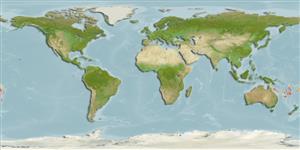Classificatie / Names
Lokale namen | Synoniemen | Catalog of Fishes(Genus, Soort(en)) | ITIS | CoL | WoRMS | Cloffa
Environment: milieu / climate zone / depth range / distribution range
Ecologie
marien bathydemersaal; diepte 250 - 320 m (Ref. 28982). Deep-water
Western Pacific: New Caledonia.
Grootte / Gewicht / Leeftijd
Maturity: Lm ? range ? - ? cm
Max length : 13.3 cm SL mannelijk / geslacht onbekend; (Ref. 28982); 11.3 cm SL (female)
Mouth small, upper-jaw length on eyed side 2.8 to 3.1 times in head length. Pectoral fin on eyed side much less than head length in both sexes. Body comparatively deep. Maximum SL about 12.1 cm (Ref 42535).
Levenscyclus en paargedrag
Maturities | Voortplanting | Spawnings | Egg(s) | Fecundities | Larven
Amaoka, K., E. Mihara and J. Rivaton, 1997. Pisces, Pleuronectiformes: Flatfishes from the waters around New Caledonia. Six species of the bothid genera Tosarhombus and Parabothus. p.144-171. In B. Séret (ed.) Résultats des Campagnes MUSORTOM,17, Mém. Mus. Natn. Hist. Nat. 174, 212p. (Ref. 28982)
Status op de Rode Lijst van het IUCN (Ref. 130435)
Gevaar voor de mens
Harmless
Gebruik door de mens
Tools
Speciale rapporten
Download XML
Internetbronnen
Estimates based on models
Preferred temperature (Ref.
123201): 6.4 - 9, mean 8.6 °C (based on 7 cells).
Fylogenetische diversiteitsindex (Ref.
82804): PD
50 = 0.5156 [Uniqueness, from 0.5 = low to 2.0 = high].
Bayesian length-weight: a=0.00912 (0.00408 - 0.02036), b=3.05 (2.87 - 3.23), in cm total length, based on LWR estimates for this (Sub)family-body shape (Ref.
93245).
Trofisch niveau (Ref.
69278): 3.5 ±0.4 se; based on size and trophs of closest relatives
Weerstandsvermogen (Ref.
120179): Gemiddeld, minimale populatieverdubbelingstijd 1,4-4,4 jaar (Assuming tmax>3).
Fishing Vulnerability (Ref.
59153): Low vulnerability (10 of 100).
